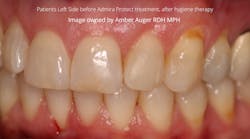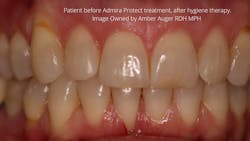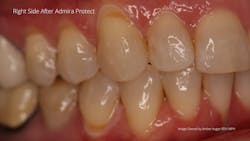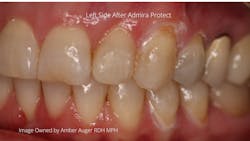Taking your hygiene department to the next level: Services beyond varnish
We’ve all treated patients with 6 mm of clinical attachment loss who miraculously have no sensitivity. In contrast, we have treated patients with localized 1–2 mm of clinical attachment loss who rocket launch out of the chair when we ever so gently probe the area. I see this often as a practicing dental hygienist.
Holland et al. define dentin hypersensitivity as "short, sharp pain arising from exposed dentin in response to stimuli, typically thermal, evaporative, tactile, osmotic, or chemical that cannot be ascribed to any other form of dental defect or pathology."1 Improper tooth brushing and periodontal disease are often the cause of dentin exposure. This sensitivity is not only uncomfortable for patients, but it also can compromise our ability to debride the area properly. Patients do not need another reason to avoid their preventive care. Admira Protect from Voco is an excellent option for patients experiencing dentin hypersensitivity.
More by Amber Auger
CaviWipes 2.0, a perfect wipe for 2022
Using fluoride varnish to combat pandemic-related oral health risks
Admira Protect is a light-cured, nano-filled desensitizer with a biocompatible ormocer matrix without glutaraldehyde. It consists of monomers, organic acids, and ormocers that include inorganic-organic copolymers and inorganic silanated filler particles that bond to the dentin when light-cured to the tooth.2 Admira Protect bonds to the tooth with a high wear resistance due to the nano-filler technology, and releases fluoride for additional protection. It has been clinically proven to prevent hypersensitivity for up to two years.
Clinical studies conducted by Maity et al. followed patients over the course of two months who were treated with light-cured desensitizers.2 Admira Protect demonstrated immediate results that lasted longer than competitor products. The contributing factors of these results are believed to be the resinous monomer that adheres to the dentin, forming the hybrid layer as well as the fillers that promote the abrasion resistance.2 This technology allows the product to remain intact even after months of brushing.
A case review
I recently treated a patient who completed her 18-month treatment with aligner therapy (figures 1-5).. When she arrived at our practice, her chief concern was hypersensitivity on teeth numbers 22, 27, and four. The patient noticed these symptoms when outside in the cold, drinking cold water, and removing her retainers. Her retainers were evaluated and smoothed to avoid rough edges that could promote gingival irritation.
The patient was instructed to lift the aligners off the teeth with a provided device from the aligner carrier to avoid pulling at the site of clinical attachment loss. The patient was previously referred to a periodontist for a consult for a gingival graft on teeth numbers 6 and 24. The patient was not interested in treatment at the time but agreed to follow up with the periodontist for a reevaluation within one year of the initial visit. A full-mouth series was taken prior to treatment, and the supervising dentists noted no tooth decay or contraindications to the light-cured desensitizer.
The patient reported a reduction in hypersensitivity the next day. After one week, she reported, “I forgot that anything ever bothered me. This is the first time in a year that I have not felt cold sensitivity, even when using my prescription toothpaste at night!" I love offering patients such immediate relief from their hypersensitivity.
Admira Protect’s light-curing technology is a procedure your dental hygienist can perform during his or her preventive hygiene therapy appointments. This treatment works best with the help of an assistant; however, the application can be performed without an assistant when the provider prepares for the procedure ahead of time. The correct CDT insurance code for this procedure is 9911.3
Voco’s light-curing, nano-filled, Admira Protect provides a solution for hypersensitive patients. Long-term relief after one application increases patient trust in your practice and helps differentiate you from the competition. Every dental hygienist should have multiple options to meet patients’ hypersensitivity needs, and Admira Protect is at the top of my list.
References
- Holland GR, Narhi MN, Addy M, Gangarosa L, Orchardson R. Guidelines for the design and conduct of clinical trials on dentine hypersensitivity. J Clin Periodontol. 1997;24:808–813.
- Maity S, Priyadharshini V, Basavaraju S. A comparative evaluation of propolis and light-cured ormocer-based desensitizer in reducing dentin hypersensitivity. J Indian Soc Periodontol. 2020;24(5):441-446. doi:10.4103/jisp.jisp_500_19
- Admira Protect, Fluoride Varnish/Desensitizer, VOCO GmbH. Voco. Accessed January 16, 2022. https://www.voco.dental/us/desktopdefault.aspx/tabid-0/httpstatus-404/
Editor's note: This article appeared in the April 2022 print edition of RDH magazine. Dental hygienists in North America are eligible for a complimentary print subscription. Sign up here.











